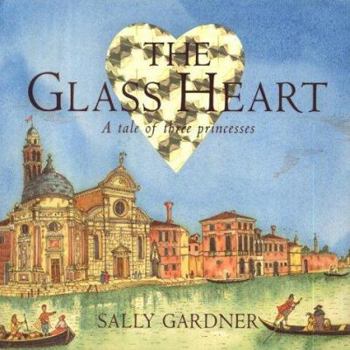The Glass Heart
Select Format
Select Condition 
Book Overview
An enchanting fairy tale about three princesses with hearts made of glass, written and illustrated by Costa and Carnegie winning Sally Gardner. This description may be from another edition of this product.
Format:Hardcover
Language:English
ISBN:1858818419
ISBN13:9781858818412
Release Date:January 2001
Publisher:Orion Childrens H/B & Trade Pb
Length:32 Pages
Weight:1.05 lbs.
Dimensions:10.9" x 0.4" x 11.0"
Customer Reviews
1 rating
"You Must Take Great Care of Your Hearts..."
Published by Thriftbooks.com User , 15 years ago
Sally Gardner specializes in what I guess should be called "fairy-princess" books, such as A Book of Princesses, Fairy Shopping and The Real Fairy Storybook: Stories the Fairies Tell Themselves. Give any or all of these picture books to a girl under eight, and she'll be yours forever. Even though I harbour a healthy distain for saccharine fairies that bear no resemblance to the darker, post-Victorian portrayal of fairies, I could never bring myself to vilify a Gardner book, despite copious amounts of the colour pink. They're just too...sincere. "The Glass Heart" is an original fairytale fitted within a framing device of a girl who breaks an ornamental glass heart belonging to her Nana. To comfort her, Nana tells her the story of three princesses with glass hearts. Having such fragile and precious hearts, the princesses are warned by their parents to be especially careful with them. However, the first princess's heart breaks at the indifference of her Prince Charming, and the second princess's heart cracks at the overwhelming beauty of a rose. So it is decided that the third princess needs a husband who is "good with glass." A young page called Valentino, who has fallen in love with the princess, decides to set forth and learn the trade of a glass-blower in the hopes that it will make him worthy of his true love's hand in marriage. There are many aspects of the traditional fairytale at work in "The Glass Heart," such as a threefold trial, a magical artifact, and a fair princess who has a condition set upon her suitors. Yet the story seems to lack a clear understanding of itself, for there are some odd messages at work here. We are told: "sometimes hearts with cracks last even longer than those without," and that "broken things can be mended so they're good as new, if not better." And yet, we see no proof of these claims in the text. Nana's glass heart is still broken; the second princess is bed-ridden all her life, and Nana ends the tale of the princesses with a somewhat irrelevant story of how she once broke her mother's milk jug. What is it to have a glass heart? Is Gardner alluding to some sort of medical condition? Or a person who is too sensitive for their own good, perhaps? Maybe she just thought it sounded nice. In any case, I was a little disappointed that the princess remain "precious," not winning herself a stronger, bolder heart, but rather a husband who can take care of it for her. Now, there's nothing inherently wrong with a delicate and fragile heroine; I like feminine heroines whose presence needn't be justified by an ability to swing a sword, but there is the sense that the princess here lacks inner strength as well. Will a child notice this? Of course not. But it might sit uneasily with parents - best to follow it up with the spunky Cinnamon from The Gypsy Princess or the clever Princess Vivian of The Princess Who Danced With Cranes. I can't believe I'm over-analyzing such a sweet, harmless little book. My cynical side wi






